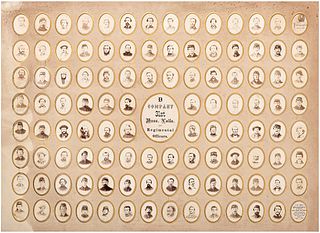The 5th Iowa Cavalry Regiment was a cavalry unit from Iowa that served in the Union Army during the American Civil War.

The 114th Illinois Infantry Regiment was an infantry regiment from Illinois that served in the Union Army during the American Civil War. Formed in September 1862, the regiment served in Ulysses S. Grant's Central Mississippi campaign, in the Vicksburg campaign, at Brices Cross Roads, at Tupelo, in the 1864 Missouri campaign, at Nashville, and at Spanish Fort. At Nashville, the unit participated in the decisive attack on Shy's Hill. In 1865, the regiment was reassigned as pontoniers. The regiment was mustered out in August 1865.
The 10th Louisiana Infantry (African descent) was a regiment in the Union Army during the American Civil War. It was composed primarily of freed or escaped slaves from Louisiana's plantations and was commanded by white officers.
The 2nd Louisiana Regiment Native Guard Infantry was a regiment in the Union Army during the American Civil War. It was organized in New Orleans and was tasked with defending the city until being redeployed to Ship Island in Mississippi. Its higher-ranking officers were white and lower grade officers and enlisted men were mixed heritage and African American.

The 6th Kansas Cavalry Regiment was a cavalry regiment that served in the Union Army during the American Civil War.
The 11th Kansas Volunteer Cavalry Regiment was a cavalry regiment that served in the Union Army during the American Civil War.

The 5th Tennessee Cavalry Regiment was a cavalry regiment that served in the Union Army during the American Civil War. This regiment was originally recruited as the 1st Middle Tennessee Cavalry.
The 2nd Regiment Colorado Cavalry was a cavalry regiment that served in the Union Army during the American Civil War.
The 2nd Ohio Cavalry Regiment was a cavalry regiment that served in the Union Army during the American Civil War.
The 2nd Maine Cavalry Regiment was a cavalry regiment that served in the Union Army during the American Civil War.

The 3rd Rhode Island Cavalry Regiment was a cavalry regiment that served in the Union Army during the American Civil War. The regiment briefly served dismounted as infantry in the defenses of New Orleans, June–September, 1864.

The 118th Illinois Volunteer Infantry was an infantry regiment in the Union Army during the American Civil War. On June 10, 1863, the regiment was converted to mounted infantry.
The 4th Regiment Arkansas Volunteer Cavalry was organized in 1863 at Little Rock December. Attached to Post of Little Rock, Arkansas, 7th Army Corps, Department of Arkansas, to May, 1864. 3rd Brigade, 1st Division, 7th Army Corps, Department of Arkansas, to September, 1864. 2nd Brigade, Cavalry Division, 7th Army Corps, to February, 1865. Unassigned, 7th Army Corps, to March, 1865. Cavalry Brigade, Little Rock, Arkansas, 7th Corps, to June, 1865.
The 1st Connecticut Cavalry Regiment was a cavalry regiment that served in the Union Army during the American Civil War.
The 29th Missouri Infantry Regiment was an infantry regiment that served in the Union Army during the American Civil War.

The 75th New York Infantry Regiment was an infantry and mounted infantry regiment in the Union Army during the American Civil War.

The 31st Massachusetts was an infantry regiment that served in the Union Army during the American Civil War. It was converted into a mounted infantry regiment in December 1863.
The 4th Massachusetts Volunteer Cavalry Regiment was a cavalry regiment that served in the Union Army during the American Civil War.
The 2nd United States Colored Infantry was an infantry regiment that served in the Union Army during the American Civil War. The regiment was composed of African American enlisted men commanded by white officers and was authorized by the Bureau of Colored Troops which was created by the United States War Department on May 22, 1863.
Battery K, 2nd Missouri Light Artillery Regiment was an artillery battery that served in the Union Army during the American Civil War and Plains Indian Wars.






